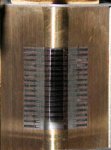elly-d, sorry for the frustration you are experiencing...
Yes...do keep us posted.
I was trying to find a shot of the rec/play head on the E-16 but I can't find a clear one to see if it has the "edge-slots" cut in it.
Go to the
What BAD HEADS Look Like!!! page at
www.analoguerules.com.
Maybe you've seen this before, but the last two pictures and text on that page talk about the edge slots:
"...'edge-slots' which are grooves cut at the top and bottom of the head
at the upper and lower sections of the tape path... so the edges of the
tape rides in the grooved-out area and will not cut ridges in the heads.
The ridges in this image will collect tape oxide, get dirty and if the
tape was cut slightly larger than the wear pattern has been cut into the
head, the tape could not ride in the groove correctly....
causing all sorts of problems."
Elly-d, did something happen in transit that would cause you to question if it was "knocked out of alignment"? Did you personally transport it?
If the tape is brand new, and it is happening with two different brands of tape, I would say, sight unseen, that your tape path is either seriously mis-aligned, or you have an abnormal wear issue.
I can't really say more without seeing some pictures, but please know, at least in my experience, tape does not "always makes 'dust'"...the only dust on
my Tascam 58 is whatever fell out of the air in my studio. I recently set it up and noticed a small orange line on the pinch roller adjacent to track 1, but it was from my older calibration tape and I rectified the issue because I found the cause and it was a slight tape path alignment issue.
Do you have a manual for your E-16? Typically mechanical tape path alignment is not complicated (and I'm talking about the
guides here...
not mechanical alignment of the heads; azimuth, zenith and wrap which
do require special test gear...) Guides can usually be done with readily available and affordable tools.
i have been told that i have 80% life left in the heads they are worn and the tape does sit in a channel i guess
Was this substantiated by a head report or just somebody's opinion? Be wary of the latter. Again, refer to the BAD HEADS page at analoguerules.com. It shows you how you can at least visually diagnose if your heads are shot or if there are other mechanical alignment issues going on.
i wouldnt want to move the heads though.
Yes. That is right. Unless you know what you are doing and/or have related experience and the right equipment and manual to go along with it, I wouldn't touch the position of the heads, but
do have it addressed if there is a problem that needs addressing.
Hang in there and, again, keep us posted. We'll be watching.


 I really need to learn to look on my own hard drive first... it's a bit larger than the Internet at this point.
I really need to learn to look on my own hard drive first... it's a bit larger than the Internet at this point. 
